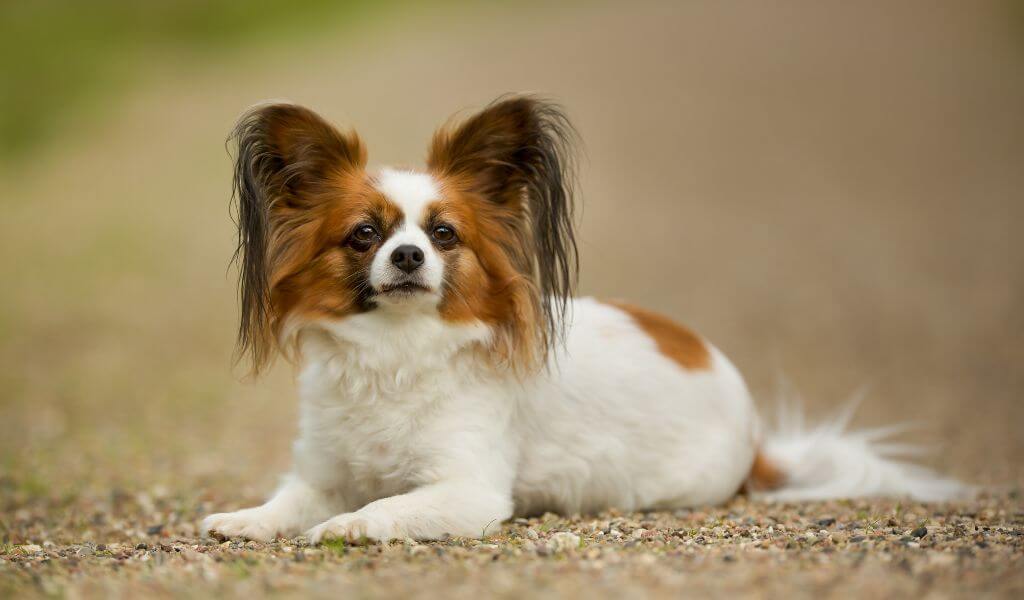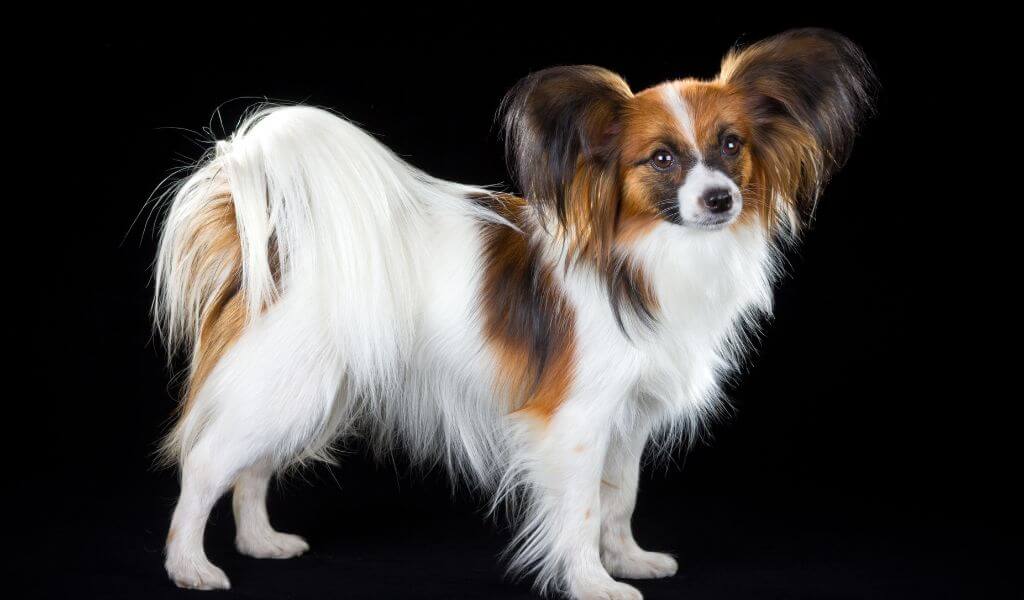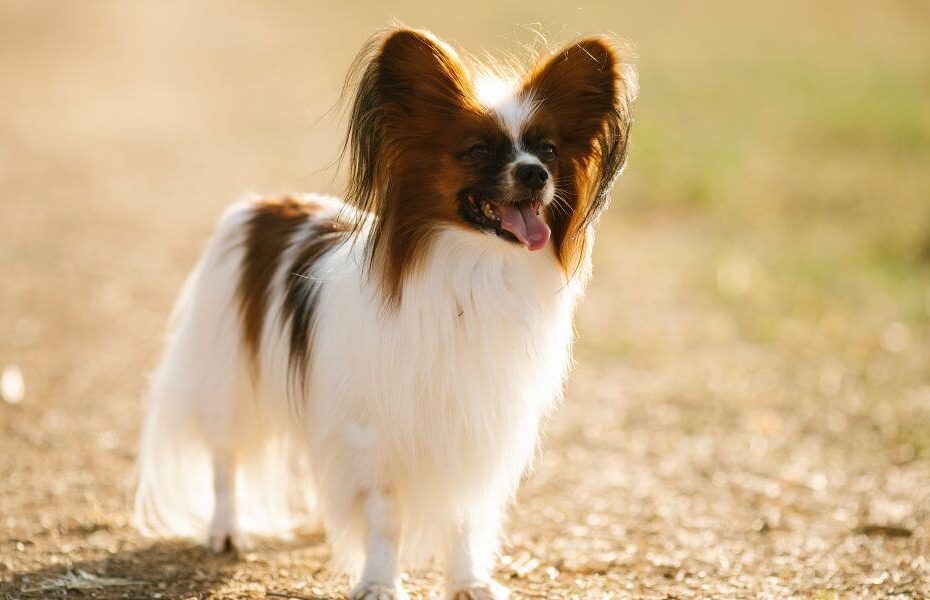Papillon dogs are intelligent, confident dogs. and it is also be very playful and affectionate. The Papillon, often known as the Continental Toy Spaniel, is a spaniel-type dog breed. One of the earliest toy spaniels, its name comes from the butterfly-like appearance of the long and fringed hair on the ears. A phalen is called a papillon because of the drooping ears.
Content Overview
Papillon overview
- Origin: France, Belgium
- Height: 8 to 11 inches males and 9 inches bitches
- Weight: 6 to 10 pounds males and 6-10 pounds bitches
- Coat: Straight, long and single-layer,
- Coat Color: White with markings and a color mask, usually red, sable, black, or lemon.
- Life Span: 14 to 16 years
- Temperament: Intelligent, happy, friendly, energetic and alert
- Hypoallergenic: No
- Group: Toy
- Common nicknames: Butterfly dog, Squirrel dog
- Other name: Continental Toy Spaniel, Epagneul Nain Continental
- puppy price: average puppy price $1000 to $2000
History
The papillon is a descendant of the European Toy Spaniel. These spaniels may be found in paintings of European royal courts dating back to the early 16th century. Titian, the most famous of these court artists, began using small spaniels in his works from 1500.
The AKC officially recognized the Papillon in 1935, with the creation of the Papillon Club of America. Among the 155 breeds and variations registered with the American Kennel Club, the Papillon is ranked 35.
Appearance
Papillons are very intelligent and personality canine who enjoy learning new skills. These dogs are friendly with children and strangers, but they are wary of new people.
The papillon’s ears are the most striking characteristic. They are naturally large and standing straight, with long, feathery hair framing her face in gigantic fans that resemble butterfly wings. A less common version is born with pendant ears sometimes known as drop ears and is known as phalene.
The ears of a papillon a small intelligent face with wide, dark eyes and Their little bodies 11 inches tall and weighing less than 10 pounds, have covered in a single coat of long fur in a range of hues, usually white with some mix of fawn, chocolate, or black.
Temperament
Papillons have the temperament of a joyful, sociable, adventurous . They are hardly shy nor aggressive in general. However, because to a little child’s lack of understanding of a dog’s behavior and the likelihood that they would do something to upset the dog, they should be supervised around small children, as should any dog.
These breeds are generally joyful, gregarious dogs who like sitting on laps as running about the home. They are clever and energetic, yet do not bark excessively.
Health
Papillons have relatively minimal health issues, including as patellar luxation, convulsions, and dental problems. They may also be susceptible to progressive retinal atrophy, intervertebral disc disease, and allergies.
Their small mouths might create dental problems, and their kneecaps can sometimes move out of position, a disease called as “luxating patellas”.
Hypoglycemia is also another problem with the breed. Papillons may have an open fontanel, a soft part of the skull that should close up and harden after six months of birth. The fontanel never entirely shuts in a few dogs, although they generally have typical lives. Progressive retinal atrophy is an eye ailment that can occur in Papillons.
Neuroaxonal dystrophy is a disease that affects the Papillon and other breeds. Puppies with this condition may appear clumsy or awkward, and they may move in an unusual, high-stepping pace. The disease is chronic and progressive, and afflicted dogs seldom live a few months.
Care
Papillons are intelligent dogs that may be trained to compete in dog sports or training contests. The Papillons like companionship and mental stimulation, and if they are left alone for extended periods of time, they can develop separation anxiety and behavior problems.
The Papillons require a lot of active playing. They should be exercised by taking 20- to 30-minute walks every day. It’s also a good idea to have a yard or dog park where they can run about.
Be careful that because they have a single-layer coat, they may require protection or a sweater during walks in cold weather, although they endure hot weather well.
Feeding
The amount of food your adult dog eats is determined by his size, age, structure, digestion, and activity level. To increase the weight of papillons their food should include biologically suitable proteins, healthy fats, small bones, and vegetables – all of which are high in critical vitamins and minerals for optimal health and performance.
If you discover papillon has gained weight, see veterinarian for advice on a feeding regimen, dog food, and exercise that will help keep your dog at the proper weight.
Grooming
To papillon dogs Regular Brushing also helps to keep teeth clean. should be washed on a regular basis to avoid having a doggy stench. The nails of papillons, like those of all breeds, should be cut on a regular basis.
The papillon has a long, fine, silky single layer hair coat that requires moderate grooming in it specifically hair brushing two to three times a week. However, the hair does not grow continuously, And oil should be put to it.
He sheds seasonally, and you may wish to use a shedding blade to remove surplus hair during that and that Keep in mind that his skin is delicate.
Wipe the dirt outward from the outer ear canal using a cotton ball. If your Bloodhound’s ears get infected despite best efforts, consult your veterinarian to establish the source of the illness.
Training
The Papillon can be surprising since they are intelligent, quick to learn, and like working with their owners. This makes them a pleasure to train, and they may easily become the stars of their training class. Papillons like playing tricks and following command. They can be socialized to along with other animals, even cats.
They like to be the pack leader with other dogs in the household and will even be the pack leader with people if they are not properly trained. This can result in little dog syndrome, in which the dog shows undesirable behaviors such as leaping up and growling at its owner.
Characteristics of the Papillon
| Energy Level | High |
| Friendliness | High |
| Kid-Friendly | Medium |
| Pet-Friendly | Medium |
| Exercise Needs | High |
| Playfulness | High |
| Affection level | High |
| Energy level | Medium |
| Trainability | High |
| Intelligence | High |
| Tendency to Bark | High |
| snore | low |
| Amount of Shedding | Low |
| Attention need | High |
| length | Medium |
| Characteristics | Straight |
| Overall Grooming Needs | Medium |
Advantages and Disadvantages
Advantages
- Friendly
- Very trainable
- Playful and active
- Generally healthy
- Excellent companion
- Polite to strangers.
- Simple to transport
Disadvantages
- Dislikes being left alone
- Can be more active than anticipated
- Barking tendencies
- needs a lot of attention
- Younger children may not be a suitable.
- Can quickly become agitated
READ ALSO: Border Collie Dog
Image



